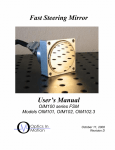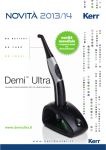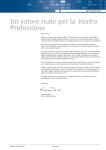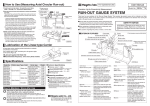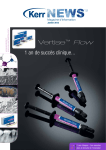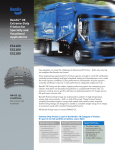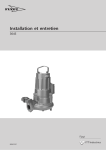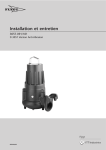Download Installation and Operating Instructions Electric Vibrators HV/VFL Series
Transcript
Installation and Operating Instructions Electric Vibrators HV/VFL Series Original Instruction Würges Vibrationstechnik GmbH Daimlerstraße 9 D-86356 Neusäß Telephone +49 8 21 46 30 81 Telefax +49 8 21 46 30 84 E-Mail [email protected] Webwww.wuerges.de Contents 1. General Information Page 3 2. Symbols Used Page 4 3. Safety • Intended use • Skilled personnel qualifications • General safety instructions Page 5 4. Technical Data • Type designation • Nameplates • Design and function Page 7 5. Transport and Storage Page 10 6. Installation and Startup • Installation • Electrical connection Page 11 7. Centrifugal Force Adjustment Page 15 8. Servicing/Maintenance Page 18 9. Spare Parts Page 20 10. Disposal/Recycling Page 21 2 1. General Information The instruction manual must be read and understood by each person in the owner‘s company who is involved in the installation, startup, maintenance and repair of electric vibrators. The same applies to additional instructions for modified motors. Würges electric vibrators are designed and built to state-of-the-art standards and operate safely if used as intended. They conform to the EC Machinery Directive 2006/42/EC, the Electromagnetic Compatibility Directive 2004/108/EC and the Low-Voltage Directive 2006/95/EC. The instruction manual must be read carefully and in full before using the vibrator motors. The spare parts list of the respective motor is to be consulted for improved understanding! 3 2. Symbols used The following information and hazard symbols are used in these installation and operating instructions: ATTENTION Important information regarding operations or procedures to which particular attention is to be paid. EXPLOSION HAZARD Refers to the possibility of fatal, severe or irreversible injuries caused by use of the product in an explosive atmosphere. HAZARD Refers to the possibility of fatal, severe or irreversible injuries caused by live parts. WARNING Refers to the possibility of fatal, severe or irreversible injuries caused by general hazards. HOT SURFACE Refers to the possibility of severe or irreversible injuries caused by touching hot surfaces. DISCONNECT Refers to the fact that the motor must be MOTOR FROM MAINS disconnected from the electricity mains and secured against being switched back on again before any work is carried out on the motor. ENVIRONMENTALLY Refers to the obligation to ensure environCOMPATIBLE DISPOSAL mentally compatible disposal. 4 3. Safety Intended use Skilled personnel qualifications Electric vibrators are not independently functioning machines. They are used as the drives of vibrating machines such as vibratory conveyor troughs, conveyor pipes, screening machines, grading/sorting machines and knock-out grids. The installation/assembly, startup and maintenance may only be carried out by authorised and qualified skilled personnel. These machines use vibrations to screen, convey, remove, compact and sort or grade. Any other use is deemed to be not as intended or misuse. Electric vibrators are designed to generate forces that can be destructive. The vibrating machine must be designed for the forces generated by the electric vibrators. The owner is responsible for the operation of electric vibrators. 5 General safety instructions Electric vibrators generate vibrations. The owner of vibration machines must protect their employees against actual or possible risks to their health and safety caused by the effect of vibrations. Würges Vibrationstechnik GmbH refuses to accept the responsibility for any damage to property or personal injuries if technical changes have been made to the product or the instructions and regulations in this instruction manual have not been noted and followed. Live parts can cause severe or fatal injuries. Electric vibrators must be safely disconnected from the electricity mains before any work is carried out on them. The required procedure is as follows: 1. Switch off vibrator motor 2. Secure against being switched back on again 3. Test for safe disconnection from the power supply 4. Allow the vibrator motor to cool Do not touch the vibrator motors while they are running or soon after switching them off. The surface temperature of the vibrator motors can reach such high values during operation that there is a risk of burns. HV/VFL series vibratory motors may not be used in hazardous areas (potentially explosive atmospheres). 6 4. Technical Data 4.1. Type designation Size/ Basic working moment HV 2 / 2 - 6 B2 Housing hole pattern Number of poles Working moment 4.2. Nameplates Size HV 0,1 – HV 2: 1. Type designation 2. Mains voltage 3.Speed 4. Power factor cos φ 5. Serial number 6. Thermal insulation class F (155°C) 7. Power input 8. Year built 9.Capacity 10. Mains frequency 11. Nominal current 12. Additional info e. g. 2MV; PTC thermistor 7 Size HV 6 and larger: 1. Type designation 2. Centrifugal force 3. Mains voltage 4.Speed 5. IP protection 6.Capacity 7. Year built 8. Power factor cos φ 9. Mains frequency 10. Serial number 11. Thermal insulation class F (155°C) 12. Power input 13. Nominal current 14. Working torque 15. Additional info e. g. 2MV; PTC thermistor 8 4.3 Design and function (using example of HV 6) This means a rotating body, whose weight is not distributed rotationally symmetrical or dynamically balanced and therefore causes vibrations. The size of these vibrations can be controlled by weights and counterweights. The electrical drive of the HV/VFL series is an asynchronous motor. The exception is the type HV 2 GL, which has a direct current motor as a drive. In the sizes HV 1 and HV 2 the stator is cast under vacuum and therefore forms an assembly permanently connected to the housing. On both shaft ends of the motor there are eccentric unbalance plates. 1 2 3 4 Protective cover Armature Stator Housing 5 6 7 8 Cable gland Terminal box cover Bearing end shield Rolling bearing 9 Terminal board 10 Unbalance plates 11 Terminal box seal 9 5. Transport and Storage Vibrator motors must always be stood on their bases or footings! Do not stack vibrator motors! When they are delivered the motors must be checked for visible transport damage! If the motor is visibly damaged it must not be started up. The vibratory motor must be examined and if necessary returned to the manufacturer for repair. Until they are installed the electric vibrators should be stored in enclosed, dry rooms at a max. ambient temperature of 40° C. Do not lift up the motor by its installed connection cable. The eyebolt of the size HV 55 and larger motors is solely intended for lifting the vibration motor. Note and follow the local accident prevention regulations. 10 6. Installation and Startup Assembly/Installation The bolts must be secured against mechanical loosening by means of spring lock washers DIN 127 Form A, DIN 7980 or Schnorr washers. Electric vibrators can be installed in any installation position. Vibrator motors may only be built on to machines with flat, oil, grease and paint-free and flexurally rigid mounting surfaces. The fixing bolts must be checked for secure fit after approx. two operating hours and if necessary retightened. Other checks should be carried out daily! Surface quality Improper fixing results in the breakage of the feet of the vibratory motor. Only bolts in quality class 8.8 > EN ISO 4014 (DIN 931); EN ISO 4017 (DIN 933) and nuts in quality class 6 > 8.8 EN ISO 4032 (DIN 934) may be used. Minimum tightening torque M 5 8 Nm M 8 30 Nm M 10 55 Nm M 12 90 Nm M 16 150 Nm Vibrator foot Mounting plate ✓ correct ✓ correct 11 incorrect M 20 280 Nm M 24 450 Nm Electrical connection/cable connection 1. Switch off vibrator motor and secure against being switched back on again 2. Check for safe isolation from supply 3. Allow the motor to cool Electric vibrators must be safely disconnected from the electricity mains before work is carried out on them. The required procedure is as follows: Star connection corresponds to higher voltage on the nameplate Delta connection corresponds to lower voltage on the nameplate Each motor must have its own upstream motor protection device as protection against possible overload; the nominal current of this protective device must be set according to the nameplate data. The electrical connection may only be made by a qualified electrician or person who has received the necessary electrical instruction in accordance with EN-60204-1. The mains voltage and frequency must correspond to the nameplate data. The motor must only be connected to an electricity system that conforms to the VDE provisions. If two counter-rotating motors are installed, it is necessary to ensure that if one motor fails both motors are switched off. 12 Speed control Cable connection The speed of our three-phase current vibrator motors can be controlled using standard electronic frequency converters. Only use flexible cables for the connection. We recommend the following cable types: HV 0,4 to HV 30: H 07 RN-F 4x1,5² HV 30 and higher: NSSHÖU-I 4x1,5² HV 2 GL: Ölflex 550P 2x2,5² Please ask about the maximum allowable final speed for each motor type! Speed reduction is easily possible for each type. In case of speed increase above the value given on the nameplate there is a risk of accidents caused by impermissibly high centrifugal forces. Plastic cables are unsuitable. Attach cable lugs or crimp-type cable sockets to the wire ends. Never solder on cable lugs or sockets, as the wire strands near the solder point can break under vibration. Feed the cables into the terminal box and connect as shown in the circuit diagram above. (See page 14). Except HV 0.4 and HV 0.8. These are connected to a European-style terminal strip. When tightening the cable gland cap nut, ensure that the cable sheath is still fully covered by the seal. If not, the cable will not be securely fixed in place, will not be strain-relieved and will not be watertight. 13 Re-close the terminal box with seal and screw locking device. The power input must be checked during the initial startup. If this is larger than the value given on the nameplate this can be remedied by lowering the centrifugal force. (See Chapter 7). The motor connection cable must be laid fixed for approx. 0.5m after it exits from the motor. The first fixing point of the cable and the motor must not be able to move against each other The cable must be checked occasionally for during operation. The connection cable must be chafing and if necessary the cause must be laid so that natural oscillations are avoided and removed. there is no tensile loading of the cable. Maximum tightening torque terminal board nuts M 4 1,2 Nm 14 M5 2,0 Nm 7. Centrifugal Force Setting Crushing hazard when setting the centrifugal force. Ensure that the armature is fixed. Note and follow the safety instructions on page 6! The centrifugal force has a direct effect on the vibration amplitude of the machine and the power input of the motor. To adjust the centrifugal force, dismantle both protective covers and undo the unbalance fixing. If no special centrifugal force setting has been ordered, the motor is set to maximum centrifugal force in the factory. HV 0,4 – HV 15, HV 30/2 and HV 55/2 The centrifugal force is reduced by turning the unbalance plates through 180° at both ends. In the case of size HV 0.4 to HV 15, HV 30/2 and HV 55/2 motors the centrifugal force is adjusted in steps by means of push-on unbalance plates. ✓ ✕ correct incorrect Maximum tightening torque of nuts at the shaft end The number of plates changed rotated through 180° must be the same at both ends of the shaft, i. e. they must be symmetrical. (See Fig.) The unbalance plates can also be removed for fine adjustment, they must then be replaced by spacer discs. HV 0,4/2 HV 1 HV 6 15 M 5 M 5 M 6 3 Nm 3 Nm 20 Nm Centrifugal force adjustment by means of push-on unbalance plates The centrifugal force of the motor reduces as follows if the push-on unbalance plates are rotated through 180° or removed: Speed 2-pole, 3000 min-1 Motor Centrifugal force rotated through 180° removed HV 0,4/2 50 N 25 N HV 0,8/2 100 N 50 N HV 1/2 100 N 50 N HV 2/2 220 N 110 N HV 6/2 380 N 170 N HV 8/2 380 N 170 N HV 12/2 750 N 375 N HV 15/2 750 N 375 N HV 15/2-20 750 N 375 N HV 15/2-25 1260 N 630 N HV 30/2 1260 N 630 N HV 55/2 2100 N 1050 N Speed 4-pole, 1500 min-1 Motor Centrifugal force rotated through 180° removed HV 1/4 25 N 12,5 N HV 2/4 55 N 27,5 N HV 6/4 95 N 47,5 N HV 12/4-30 187,5 N 93,75 N HV 12/4-42 350 N 175 N Speed 6-pole, 1000 min-1 Motor Centrifugal force rotated through 180° removed HV 6/6 42,5 N 21,25 N HV 12/6-42 148,67N 74,34 N Speed 8-pole, 750 min-1 Motor Centrifugal force rotated through 180° removed HV 6/8 23,75 N 11,88 N HV 12/8-42 87,33 N 43,67 N 16 HV 30/4-75 – HV 85 From size HV 30 (except HV 30/2 and HV 55/2) the centrifugal force is adjusted by turning the two outer unbalance plates. The percentage centrifugal force can be read off from the scale on the shaft. The adjustment made must be symmetrical. For minimum tightening torques of the bolts see page 11 ✓ After the centrifugal force has been adjusted the loosened bolts and nuts must be retightened and the protective covers must be refitted. Otherwise there is a risk of accidents! To ensure watertightness ensure that the seals are intact when dismantling and installing the protective covers. Damaged seals must be replaced. correct ✕ Never operate motors without unbalance plates. This causes damage to the bearings. incorrect 17 8. Servicing/Maintenance The electric vibrators must always be disconnected from the electricity mains before any work is carried out on it! Lubrication The bearings of the vibratory motors up to size HV 65 are lubricated for life. It is not normally necessary to carry out maintenance work on the bearings of these motors. 1. Switch off vibrator motor 2. Secure against being switched back on again 3. Test for safe disconnection from the power supply 4. Allow the vibratory motor to cool We recommend the following lubrication intervals for size HV 85 and larger: Maintenance work to be carried out regularly • The surfaces of the motors must be kept free from dirt deposits in order to ensure adequate cooling. • Check the connection cable for chafe marks and if applicable remove whatever is causing them. • Check fixing bolts for secure fit and if necessary retighten. • Check the seals The fixing bolts must be retightened after approx. two operating hours (following startup). Other checks should be carried out daily. 18 Motor Lubrication Grease typeinterval quantity in hours in grams HV 15/2* 1000 3 HV 30/2* 800 4 HV 55/2* 500 5 HV 85/2 300 4 HV 85/4 600 3 Supermat200 3 * For especially high loads, various motors, some as special designs, are equipped with lubrication nipples DIN 71412 for regreasing. Please contact us! Allowable operating temperature The lubrication intervals apply to 50 Hz operation. In case of 60 Hz operation we recommend halving the lubrication intervals and quantity of grease. The temperature on the outside of the housing must not exceed 80°C. This limit can be exceeded if the power input is too high, if the speed given on the nameplate is not reached. This can cause the winding to burn out. We recommend the following long-life grease: ESSO UNIREX N3. In case of signs of bearings wear the motors should be switched off immediately and the special bearings replaced. A possible cause is that the centrifugal force is too high for the specific application or the design is insufficiently flexurally rigid. We recommend that you send the motors to the manufacturer for repair (including if other types of damage occur). This is the only way to ensure proper repair. One remedy is to reset the centrifugal force or to use a motor with stronger electrical drive. 19 9. Spare Parts We expressly point out that spare parts and accessories that are not original parts supplied by us have not been tested and approved by us. Installing and/or using such products can therefore cause negative changes to the specified design properties and therefore impair active and/or passive safety. To order spare parts, please refer to the spare parts list of the respective motor. (See: www.wuerges.de/downloads) Please always give the following information with each order for spare parts: • Motor number • Motor type • Description, item and order number of the part • Required quantity Würges does not accept any liability whatsoever or provide any warranty for damage caused by the use of non-original spare parts and accessories. For further information, please refer to the exploded views given in the spare parts list. We only provide warranty for the original spare parts supplied by us. 20 10. Disposal and Recycling Packaging materials and motor components must be disposed of in an environmentally compatible way. PE: Seals/gaskets Steel: Unbalance plates, armature and rotor, bolts, nuts and bearing Copper and synthetic resin: Winding Aluminium: Housing, protective covers, terminal box cover and nameplate You can return the motors to us for proper disposal! They must be delivered to us carriage paid. 21 Notes 22 Notes 23 Würges Vibrationstechnik GmbH Daimlerstraße 9 D-86356 Neusäß Telephone +49 8 21 46 30 81 Telefax +49 8 21 46 30 84 E-Mail [email protected] Webwww.wuerges.de © 4/2014 24
























